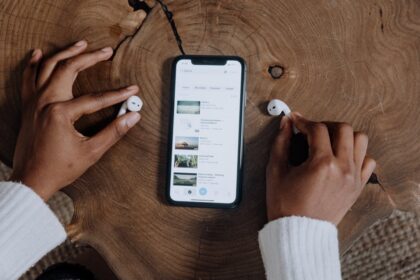Mastering Your First Social Media Ad Campaign
Understanding the Digital Advertising Landscape for Beginners
Embarking on your first social media ad campaign is a pivotal step in expanding your brand’s reach and achieving specific business objectives. The digital advertising landscape is vast, dynamic, and incredibly powerful, offering unparalleled precision in targeting and measurable results. Unlike traditional advertising, social media platforms allow for real-time adjustments, deep audience segmentation, and direct interaction with potential customers. This shift from broad-stroke marketing to highly personalized outreach fundamentally changes how businesses connect with their market. The allure lies in the ability to put your message directly in front of the exact individuals most likely to convert, whether that’s through a purchase, a lead form submission, or increased brand awareness. Social media platforms, with their massive user bases and sophisticated data insights, provide a fertile ground for cultivating new customer relationships and nurturing existing ones. The initial investment in understanding this landscape pays dividends, equipping you with the foundational knowledge to navigate its complexities and harness its immense potential.
However, the path to social media advertising success for a novice is often fraught with common pitfalls. Many beginners dive in without clear objectives, leading to campaigns that lack direction and waste precious budget. Another frequent misstep is inadequate audience research; targeting too broadly or too narrowly based on assumptions rather than data can severely hamper performance. Neglecting the quality of ad creatives and copy, failing to optimize landing pages, or simply “setting and forgetting” campaigns are also prevalent errors that stifle early progress. A common pitfall involves misinterpreting key metrics or focusing on vanity metrics that don’t directly correlate with business goals, leading to skewed perceptions of success or failure. Furthermore, many new advertisers underestimate the importance of continuous monitoring and optimization, treating ad campaigns as static entities rather than fluid, evolving strategies. Overcoming these initial hurdles requires a systematic approach, a willingness to learn from data, and an understanding that even a perfectly executed campaign needs nurturing. Setting realistic expectations from the outset is paramount. Your first campaign is a learning experience, an opportunity to gather data, understand your audience’s response, and refine your approach. It’s improbable that a beginner’s first campaign will achieve astronomical ROI immediately, but it’s entirely plausible it will provide invaluable insights that pave the way for future successes. Focus on the learning curve, treat initial ad spend as an investment in data collection, and celebrate incremental improvements as you build proficiency.
Phase 1: Pre-Campaign Planning & Strategic Foundations
Before even thinking about ad formats or budgeting, the absolute cornerstone of any successful social media ad campaign, especially your first, is meticulously defining your objectives. Without clear, measurable goals, your campaign will drift aimlessly, making it impossible to evaluate its effectiveness or make informed optimization decisions. The SMART framework provides an excellent guide: Specific, Measurable, Achievable, Relevant, and Time-bound. Are you aiming for increased brand awareness, driving website traffic, generating qualified leads, boosting online sales, increasing app installs, or fostering engagement with existing content? Each objective necessitates a distinct strategy, different key performance indicators (KPIs), and potentially different platform choices and ad formats. For instance, if your primary goal is brand awareness, your campaign might focus on maximizing reach and impressions, using visually striking creatives and broad targeting. Conversely, if lead generation is your aim, you’ll concentrate on conversion-focused ads, lead forms, and precise audience targeting designed to capture contact information. Linking these objectives directly to overarching business goals ensures your advertising efforts contribute meaningfully to your company’s growth. If your business goal is to increase market share by 10% in the next quarter, your social media ad objective might be to generate 500 qualified leads within 60 days. This linkage provides context and justification for your ad spend, transforming it from an expense into a strategic investment.
Once your objectives are crystal clear, the next critical step is to identify and deeply understand your target audience. This goes far beyond basic demographics. While age, gender, location, and income are foundational, true audience mastery delves into psychographics (values, attitudes, interests, lifestyles), behaviors (online purchase habits, device usage, engagement with specific content types), and pain points. Creating detailed buyer personas is an incredibly effective exercise here. A buyer persona is a semi-fictional representation of your ideal customer based on market research and real data about your existing customers. Give them a name, a job title, personal interests, challenges, and goals. What keeps them up at night? How does your product or service alleviate those pain points? What are their aspirations? Understanding these nuances allows you to craft ad copy and creatives that resonate deeply, addressing their specific needs and desires. Tools like Facebook Audience Insights (part of Meta Business Suite) are invaluable for this stage, providing anonymized data on user demographics, interests, and behaviors based on broad categories or existing customer lists. Competitor analysis can also reveal insights into who their customers are and what messaging they respond to. Don’t be afraid to conduct surveys, interviews, or analyze customer service inquiries to gather qualitative data directly from your current customer base, as they are often the best representation of your ideal future customers. The more granular your understanding of your audience, the more precise and effective your targeting will be, minimizing wasted ad spend and maximizing relevance.
Choosing the right social media platform(s) for your campaign is not arbitrary; it’s a strategic decision that directly impacts your campaign’s reach, cost-efficiency, and ultimate success. Each major platform boasts unique strengths, audience demographics, and ad capabilities.
- Facebook/Instagram (Meta): These platforms collectively represent the largest social media advertising ecosystem. Facebook is excellent for broad reach, diverse demographics, and robust targeting options including detailed interests, behaviors, and custom audiences (like website visitors or customer lists). Instagram, highly visual, excels for brand awareness, e-commerce, and reaching younger demographics through Stories, Reels, and image ads. They are strong for both B2C and increasingly for B2B engagement due to their massive user base.
- LinkedIn: The undisputed king for B2B advertising. LinkedIn allows highly precise targeting based on job title, industry, company size, skills, and professional interests. It’s ideal for lead generation for services, software, and products aimed at businesses, and for thought leadership.
- Twitter/X: Best for real-time engagement, news, trends, and driving conversations. Ad formats include promoted tweets, follower ads, and website cards. It’s particularly effective for rapid brand awareness and engagement around timely events or discussions.
- Pinterest: A visual discovery engine often used for inspiration and planning purchases. Ideal for e-commerce, lifestyle brands, home decor, fashion, and DIY. Users actively seek products, making them highly receptive to relevant ads.
- TikTok: Dominates the short-form video space, especially popular with Gen Z and younger Millennials. Excellent for viral content, user-generated content (UGC) campaigns, and driving brand awareness through highly engaging, authentic video.
- YouTube: The second-largest search engine and a powerhouse for video content. Ideal for long-form storytelling, product demonstrations, tutorials, and reaching audiences based on specific video content they consume.
Matching the platform to your audience and objectives is paramount. If you’re selling professional services to executives, LinkedIn is your go-to. If you’re selling trendy fashion accessories to Gen Z, TikTok and Instagram are likely better bets. Don’t feel pressured to be on every platform; concentrate your efforts where your ideal audience is most active and most receptive to your message. A focused approach on one or two key platforms, mastered thoroughly, will yield far better results than a scattered presence across many.
Budgeting and bidding strategies are often intimidating for first-time advertisers, but they are crucial levers in campaign performance. Understanding key ad spend metrics is foundational.
- CPM (Cost Per Mille/Thousand Impressions): The cost you pay for 1,000 views of your ad. Useful for awareness campaigns.
- CPC (Cost Per Click): The cost you pay each time someone clicks on your ad. Relevant for traffic or engagement campaigns.
- CPA (Cost Per Acquisition/Action): The cost you pay for a specific conversion, such as a lead or a sale. Essential for performance-driven campaigns.
You’ll typically choose between two primary budget types: a daily budget (a fixed amount spent per day) or a lifetime budget (a total amount to be spent over the campaign’s duration). Daily budgets offer more flexibility for ongoing campaigns, while lifetime budgets are excellent for fixed-term promotions.
Bidding strategies dictate how the platform’s algorithm spends your budget to achieve your objective.
- Lowest Cost (Automatic Bidding): The platform automatically tries to get you the most results for your budget. This is often recommended for beginners as it leverages the platform’s optimization capabilities.
- Cost Cap: You set an average cost per result you’re willing to pay. The platform tries to stay around this average. Useful when you have a target CPA in mind.
- Bid Cap: You set the maximum bid the platform can make for each optimization event. Gives you more control but can limit reach if too low.
- Target Cost: (Similar to Cost Cap, often specific to certain platforms) You set a target average cost per action, and the system attempts to maintain that average over time.
Factors influencing ad costs include audience competition (more advertisers targeting the same audience drives costs up), ad quality and relevance (high-quality, highly relevant ads are often rewarded with lower costs), seasonality (holidays, peak shopping seasons), and your chosen objective (conversions are generally more expensive than impressions). Start with a manageable budget, perhaps $10-$20 per day, to gather initial data. As you optimize and see positive results, you can gradually increase your budget. Remember, consistent monitoring of your chosen metrics against your budget is essential to ensure you’re getting a return on your investment.
Conducting competitive analysis isn’t about copying; it’s about learning. By observing your competitors’ social media ad strategies, you can gain valuable insights into what’s working (and what’s not) in your niche. Are they primarily using video ads or static images? What kind of messaging do they employ – benefit-driven, emotional, or direct-response? Which platforms do they seem to prioritize? Are they running special promotions or focusing on specific product lines? Tools like the Facebook Ad Library are incredibly powerful for this, allowing you to search any Page and see all the ads they are currently running across Meta platforms. This transparency is a goldmine for competitive intelligence. You can identify their target audiences by observing the nature of their ads and the comments they receive. Look at their call-to-actions, their landing page experiences (if accessible), and the overall customer journey they are trying to create. Pay attention to how often they post, what types of content get the most engagement, and how they handle negative feedback. Learning from their successes can inspire new ideas for your own campaigns, while understanding their failures or areas of weakness can help you differentiate your approach and avoid similar mistakes. This research helps validate your own audience assumptions, refine your unique selling proposition, and identify potential gaps in the market that your ads could address.
Phase 2: Campaign Setup & Creative Development
Setting up your ad accounts correctly is a foundational step that, if overlooked, can lead to significant headaches down the line. For Meta platforms (Facebook and Instagram), the central hub is Facebook Business Manager. This free tool allows you to manage multiple ad accounts, pages, pixels, and user permissions from one central dashboard. Within Business Manager, you’ll create or link your ad account, which is where your billing information resides and where campaigns are launched. Most critically, you must install the Meta Pixel (or relevant tracking tag for other platforms like LinkedIn Insight Tag or TikTok Pixel) on your website. The pixel is a piece of code that tracks visitor behavior on your site – page views, add-to-carts, purchases, form submissions – and sends that data back to your ad account. This data is absolutely vital for several reasons: it allows you to track conversions, optimize your ads for specific actions, build custom audiences for retargeting, and create lookalike audiences based on your valuable website visitors. Without proper pixel installation and event setup, your ability to measure ROI, refine your targeting, and optimize your campaigns will be severely limited, effectively flying blind. Ensure your website developer, or you, correctly implement the pixel and verify it’s firing properly using tools like the Meta Pixel Helper browser extension. This step is non-negotiable for any performance-driven campaign.
Crafting compelling ad copy is an art and a science. Your ad copy is the textual component of your ad, designed to capture attention, communicate value, and persuade the audience to take action. It works in tandem with your creative to deliver a powerful message.
- Headlines: The headline is often the first textual element people see. It needs to be a powerful hook. It should be concise, clear, and immediately convey a key benefit or provoke curiosity. Examples: “Unlock Your Potential,” “Save 50% Today,” “Struggling with X? We Can Help.”
- Primary Text: This is the main body of your ad copy. It should tell a story, highlight pain points your product/service solves, articulate benefits (not just features), and connect emotionally with your audience. Use clear, simple language. Employ emojis sparingly for visual appeal and tone. Break up long paragraphs with line breaks for readability. Use bullet points to list benefits.
- Call-to-Action (CTA): This is the explicit instruction for what you want the user to do next. It needs to be clear, concise, and create urgency or desire. Examples: “Shop Now,” “Learn More,” “Sign Up,” “Download Your Free Guide.” The CTA button on the ad should align with your copy.
A/B testing different variations of your ad copy is crucial for optimization. Test different headlines, opening lines of primary text, and CTAs to see which resonates most with your target audience. Focus on writing that addresses your audience’s specific needs and desires, using their language. Emphasize how your product or service provides a solution to their problems, makes their lives better, or helps them achieve their goals. Incorporate emotional triggers suchppers like fear of missing out (FOMO), desire for status, convenience, or security. Always proofread thoroughly for typos and grammatical errors, as they can severely undermine your credibility.
Designing high-impact ad creatives is equally important, as visuals are often the first thing that captures attention in a crowded social feed. Different ad formats lend themselves to different creative strategies.
- Image Ads: Must be high-resolution, visually appealing, and relevant to your message. Use vibrant colors, clear product shots, or relatable lifestyle imagery. Be mindful of text overlay rules (e.g., Meta historically preferred less than 20% text on images, though this rule is less strict now, it’s still a good guideline for performance).
- Video Ads: Increasingly dominant, especially on platforms like TikTok, Instagram, and YouTube. The first 3-5 seconds are critical to hook the viewer. Keep videos concise, convey your message quickly, and include calls-to-action within the video itself (e.g., text overlays with “Shop Now”). Consider different aspect ratios for different placements (e.g., vertical for Stories/Reels).
- Carousel Ads: Allow you to showcase multiple images or videos within a single ad, each with its own headline, description, and link. Excellent for telling a story, showcasing different product features, or presenting a range of products.
- Collection Ads: Primarily for e-commerce, these ads allow users to discover products in a full-screen experience after clicking on the ad, essentially creating an instant storefront within the platform.
- User-Generated Content (UGC): Highly authentic and often more trustworthy than polished brand content. Encourage customers to create content featuring your product, or repurpose existing UGC with their permission. This can be incredibly effective for building social proof.
Best practices across platforms include adhering to specific aspect ratios and file sizes (e.g., 9:16 for Stories/Reels, 1:1 for feed posts, 16:9 for landscape videos), ensuring clarity and quality, and constantly experimenting. Your creative should instantly communicate your brand identity and the value proposition. Don’t be afraid to test wildly different creative concepts; sometimes the most unexpected ones perform best.
The landing page experience is where the rubber meets the road. Even the most compelling ad copy and creative will fail if the landing page is subpar. The landing page is the destination users arrive at after clicking your ad, and its sole purpose is to convert that click into a desired action.
- Consistency: The landing page must maintain visual and textual consistency with the ad that led the user there. If your ad promised a 50% discount on shoes, the landing page should immediately display shoes with a 50% discount prominently. Any disconnect will create friction and lead to high bounce rates.
- Clear Value Proposition: Immediately communicate what you offer and why it’s valuable. The headline should be benefit-driven and supported by concise body copy.
- Easy Navigation & Fast Loading Speed: Users are impatient. Your landing page must load in under 2-3 seconds, especially on mobile. Cluttered navigation or too many distractions will deter conversions. Focus on a single, clear path to conversion.
- Mobile Responsiveness: A vast majority of social media users access platforms on mobile devices. Your landing page must be perfectly optimized for mobile, with large, tappable buttons, readable text, and responsive design.
- Conversion Elements: Make your call-to-action button prominent, using contrasting colors. If it’s a form, keep it short, asking only for essential information. Include trust signals like testimonials, security badges, or privacy policies.
Think of the entire ad campaign as a funnel: the ad captures attention, and the landing page converts interest into action. A well-optimized landing page is just as crucial as the ad itself for achieving your campaign objectives and maximizing your return on ad spend.
Phase 3: Launching & Initial Monitoring
Before you click the “Publish” button, a meticulous review process is essential. This final check can prevent costly errors and ensure your campaign launches smoothly and effectively. Double-check every setting: Is the correct objective selected? Is your target audience precisely defined, including any necessary exclusions? Is your budget set correctly for daily or lifetime spend? Are your bidding strategies aligned with your goals? Are all chosen ad creatives displaying correctly and in the right aspect ratios for their placements? Is your ad copy free of typos and grammatical errors? Most importantly, verify that your tracking pixel is active and correctly configured to track the specific conversion events you’re optimizing for (e.g., ‘Purchase,’ ‘Lead,’ ‘Add to Cart’). Finally, ensure your campaign complies with the ad policies of the specific social media platform. Each platform has strict guidelines regarding prohibited content (e.g., discrimination, misleading claims), restricted content (e.g., alcohol, pharmaceuticals), and acceptable ad practices. Violations can lead to ad rejection, account suspension, or even permanent bans. A thorough pre-launch checklist minimizes risk and sets the stage for a successful campaign.
Once your campaign goes live, the initial monitoring phase is critical for identifying immediate issues and understanding early performance trends. You don’t need to analyze deep conversion funnels yet, but focus on top-of-funnel metrics to ensure your ads are reaching the right people and generating initial interest.
- Reach & Impressions:
- Reach: The number of unique users who saw your ad.
- Impressions: The total number of times your ad was displayed (a single user might see it multiple times).
- Frequency (Impressions/Reach): How many times, on average, a unique user saw your ad. In the initial phase, a low frequency (1-2) is good, indicating wide distribution. If it’s too high immediately, it might suggest your audience is too small or your budget is too large for the audience size, leading to ad fatigue prematurely.
- Click-Through Rate (CTR): The percentage of people who saw your ad and clicked on it (Clicks/Impressions). A low CTR (e.g., below 1% for most campaigns) suggests your ad creative or copy isn’t resonating, or your targeting is off. A higher CTR indicates strong ad appeal.
- Cost Per Click (CPC): The average cost you pay for each click on your ad (Total Spend/Clicks). A high CPC could mean your ad is not relevant enough to the audience, there’s too much competition, or your bidding strategy is inefficient.
- Engagement Rate: The percentage of people who interacted with your ad (likes, comments, shares, clicks). High engagement signals that your content is compelling and relevant.
- Initial Conversion Rates (if applicable): If your objective is conversions, monitor the immediate trickle of conversions (leads, purchases) to ensure your pixel is firing correctly and your landing page is converting.
The goal in this initial phase is to identify “deal breakers” within the first 24-72 hours. Don’t make drastic changes yet, but look for red flags that indicate something is fundamentally broken.
Despite careful planning, it’s common to encounter issues in the initial stages of a campaign. Being able to troubleshoot effectively can save your budget and your sanity.
- Low Reach/Impressions:
- Possible Causes: Budget too low for the audience size or competition; audience too narrow; ad rejection (check platform notifications); bidding strategy too restrictive.
- Troubleshooting: Increase daily budget slightly; broaden audience slightly (if appropriate); check ad status in ad manager for rejections and reasons; switch to an automatic bidding strategy like “lowest cost” if you’re using a manual bid cap.
- High CPC (Cost Per Click):
- Possible Causes: Low CTR (ads not appealing); high competition for the audience; low ad relevance score (if the platform provides one).
- Troubleshooting: Test new ad creatives and copy to improve CTR; refine audience targeting to be more specific or find less competitive segments; adjust bidding strategy to optimize for clicks rather than just impressions.
- Low CTR (Click-Through Rate):
- Possible Causes: Irrelevant ad creative or copy to the audience; poor ad placement; audience fatigue.
- Troubleshooting: A/B test different headlines, primary text, and visuals; ensure your ad’s message directly addresses a pain point or desire of your target audience; review your audience targeting for precision; consider expanding your audience if frequency is already high.
- Ad Rejections:
- Possible Causes: Violation of platform advertising policies (e.g., prohibited content, misleading claims, excessive text on images, brand infringement).
- Troubleshooting: Immediately review the rejection reason provided by the platform; carefully read the specific ad policy guidelines; edit the ad creative or copy to comply; resubmit for review. If issues persist, contact platform support.
Initial monitoring is about rapid diagnosis and minor adjustments, not wholesale campaign overhauls. Let your campaign run for at least 3-5 days to gather sufficient data before making significant optimization decisions. The goal is to get the campaign functioning smoothly and generating measurable data, preparing for the more intensive optimization phase.
Phase 4: Optimization & Scaling
Once your campaign has gathered sufficient initial data (typically 3-7 days), it’s time for more strategic optimization. At the heart of this phase is A/B testing, also known as split testing. This systematic approach involves creating variations of your ad elements (e.g., audience, creative, copy, bidding strategy) and running them simultaneously to determine which performs best against your specific objectives.
- Audience Segments: Test different audience interests, behaviors, or demographics. For example, run the same ad to an audience interested in “eco-friendly living” versus one interested in “sustainable fashion” to see which segment responds better. Or test a broad lookalike audience against a more refined custom audience.
- Creative Variations: This is one of the most impactful areas for testing. Test different images, videos, ad formats (single image vs. carousel vs. video), color schemes, and calls-to-action embedded in the creative. Do bright, bold images perform better than minimalist ones? Does a testimonial video outperform a product demo?
- Copy Variations: Test different headlines, primary text lengths (short vs. long), opening hooks, benefit emphasis, and calls-to-action within the copy. Does a question-based headline perform better than a statement? Does highlighting “save money” resonate more than “improve efficiency”?
- Bidding Strategies: While less common for beginners to A/B test explicitly, you might experiment with “lowest cost” versus “cost cap” on different ad sets once you have a clear idea of your target CPA.
- Placement Variations: Test specific placements (e.g., Facebook News Feed vs. Instagram Stories vs. Audience Network) to see where your ads are most effective and cost-efficient. Some platforms allow automatic placements, which is often recommended for beginners, but advanced users might test manual placements.
The key to effective A/B testing is to test only one variable at a time to isolate its impact. If you change both the creative and the copy simultaneously, you won’t know which change led to the improved or declined performance. Ensure your tests run long enough to achieve statistical significance (enough impressions and conversions) before declaring a winner. Use the platform’s built-in A/B testing features where available, as they often handle audience splitting and reporting automatically.
Audience refinement is a continuous process that leverages the data you collect to make your targeting more precise and efficient.
- Excluding Non-Converting Audiences: As your campaign progresses, you’ll identify audience segments that click on your ads but rarely convert. You can create custom audiences of these non-converters and exclude them from future targeting to prevent wasted ad spend. This ensures your budget is focused on those most likely to take the desired action.
- Creating Lookalike Audiences (LALs): One of the most powerful targeting options. Lookalike audiences are created by telling the ad platform to find new users who share similar characteristics to your existing high-value customers (e.g., website purchasers, email list subscribers, engaged followers). Start with a “seed” audience of at least 1,000 highly engaged users or customers. The platform’s algorithm then identifies millions of similar individuals, allowing you to scale your reach with highly qualified prospects. Test different percentages (e.g., 1% LAL of purchasers vs. 5% LAL of website visitors) to see what works best.
- Retargeting Strategies: Essential for nurturing leads and converting hesitant prospects. Retargeting involves showing ads specifically to people who have already interacted with your brand in some way (e.g., visited your website but didn’t purchase, watched a significant portion of your video ad, engaged with your Facebook Page, or abandoned a shopping cart). These audiences are “warmer” and often have higher conversion rates because they’re already familiar with your brand. Tailor your ad copy and creative for retargeting, offering incentives, addressing objections, or reminding them of the value proposition.
Budget allocation and scaling are critical steps once you’ve identified winning ad sets and audiences. Avoid the temptation to drastically increase your budget overnight, as this can shock the algorithm and negatively impact performance, leading to higher costs.
- Shifting Budget: Once A/B tests reveal winning ads, ad sets, or audiences, shift budget away from underperforming elements and towards those that are driving results at the desired cost. If one ad creative has a significantly higher CTR and lower CPA, allocate more budget to that specific creative.
- Gradual Scaling Techniques: For Meta Ads, a common practice is to increase the daily budget of a successful ad set by no more than 10-20% every 2-3 days. This allows the algorithm to adjust gradually without disrupting its learning phase. If you have multiple successful ad sets, consider consolidating them into a single “Campaign Budget Optimization” (CBO) campaign, where the platform automatically allocates budget to the best-performing ad sets within that campaign.
- Avoiding “Sticker Shock” for Algorithms: Rapid, large budget increases can reset the learning phase of the algorithm, leading to unpredictable performance and potentially higher costs per result as the system tries to re-optimize. Patience and gradual increases are key to stable, scalable growth.
Ad fatigue is a real phenomenon where your target audience becomes oversaturated with your ads, leading to declining performance metrics (e.g., lower CTR, higher CPC, decreased engagement) and an increasing frequency metric.
- Identifying Ad Fatigue: Monitor your frequency metric. If it consistently rises above 3-5 (meaning people are seeing your ad 3-5+ times on average), it’s a strong indicator of fatigue. Also look for a concurrent decline in CTR and rising costs.
- Refreshing Creatives and Copy: The most direct solution. Launch new ad creatives (images, videos) and fresh ad copy. Even subtle changes can make an ad feel new and re-engage your audience.
- Expanding Audience: If your frequency is high, your audience might be too small for your budget. Consider expanding your target audience slightly, creating new lookalike audiences, or exploring new interest groups to introduce your ads to fresh eyes.
- Negative Retargeting: Exclude people who have already converted or seen your ad too many times from your main targeting to prevent annoyance and wasted impressions.
Advanced bidding and optimization strategies can be implemented as you gain experience and collect more data.
- Value Optimization: For e-commerce businesses, platforms like Meta allow you to optimize for the value of purchases, not just the number of purchases. This trains the algorithm to find customers likely to spend more, directly impacting your ROAS.
- Minimum ROAS (Return on Ad Spend): You tell the platform the minimum ROAS you’re willing to accept, and it will try to deliver purchases that meet or exceed that target. This can be restrictive if set too high initially.
- Dynamic Creative Optimization (DCO): Allows you to upload multiple variations of ad copy, headlines, images, and videos. The platform automatically mixes and matches these elements to create the best-performing combinations for each individual user, learning and optimizing over time. This automates A/B testing at scale.
Finally, consider cross-platform integration and synergy. While your first campaign might focus on one platform, future campaigns can benefit from a coordinated multi-channel approach. Utilize data from one platform to inform strategies on another. For example, insights from your Facebook audience research might guide your targeting on LinkedIn. Running coordinated campaigns means your message remains consistent across touchpoints, reinforcing brand identity and guiding customers through a more comprehensive sales funnel. A user who sees your brand on Instagram might then see a retargeting ad on Facebook, or discover your long-form content on YouTube. This multi-touch approach often leads to higher conversion rates as it builds trust and familiarity.
Phase 5: Measurement, Reporting & Iteration
Understanding attribution models is fundamental to accurately assessing your social media ad campaign’s performance, especially as you begin to explore multi-channel marketing. Attribution refers to how credit for a conversion (e.g., a sale, a lead) is assigned to the various touchpoints a customer interacted with before converting. Different models offer different perspectives:
- Last-Click Attribution: Gives 100% of the credit to the very last click before conversion. This is the default for many platforms and simple to understand, but it often undervalues earlier interactions (like an initial awareness ad).
- First-Click Attribution: Assigns all credit to the very first interaction. Good for understanding what initiates interest but ignores subsequent nurturing.
- Linear Attribution: Distributes credit equally across all touchpoints in the customer journey.
- Time Decay Attribution: Gives more credit to touchpoints that occurred closer in time to the conversion.
- Position-Based (U-shaped) Attribution: Assigns more credit to the first and last interactions, with the remaining credit distributed evenly across middle interactions.
For a first campaign, last-click is often the easiest to start with, as it’s typically how the ad platforms report. However, as you mature, understanding that social media ads often play a role in discovery (first touch) or nurturing (middle touch) even if another channel gets the “last click” is vital for holistic analysis. Tools like Google Analytics can provide more comprehensive cross-channel attribution insights if properly integrated.
Beyond general metrics, focusing on specific Key Performance Indicators (KPIs) directly tied to your initial objectives is crucial for evaluating success.
- Return on Ad Spend (ROAS): For sales-driven campaigns, this is paramount. It measures the revenue generated for every dollar spent on ads (Revenue from Ads / Ad Spend). A ROAS of 3x means you made $3 for every $1 spent.
- Cost Per Acquisition (CPA): If your objective is leads or specific actions, CPA is your critical KPI (Total Ad Spend / Number of Conversions). What’s the cost to acquire a new lead or customer? Is this sustainable and profitable?
- Customer Lifetime Value (CLTV): While not directly measurable within a single campaign, understanding CLTV helps justify a higher CPA for acquiring valuable customers. If a customer typically spends $500 over their lifetime, you can afford to spend more than $50 to acquire them.
- Conversion Rate: The percentage of ad clicks or landing page visitors that complete your desired action (e.g., purchases/clicks or leads/landing page visitors). A low conversion rate, even with good clicks, indicates issues with your landing page or offer.
- Brand Lift: For awareness campaigns, this measures the direct impact of your ads on brand perception, recall, and favorability. Platforms offer brand lift studies for larger spends, but for beginners, tracking brand mentions, organic search volume for your brand name, and social media follower growth can serve as proxies.
Regular reporting and analysis transform raw data into actionable insights. Don’t just glance at the numbers; dig into them.
- Custom Dashboards: Set up custom dashboards within your ad platform (e.g., Meta Ads Manager reporting tools) and potentially in a consolidated platform like Google Analytics or a third-party BI tool. Focus on displaying your key KPIs prominently.
- Weekly/Monthly Performance Reviews: Schedule dedicated time to review campaign performance. Look for trends: Is your CPA rising? Is your ROAS declining? What segments of your audience are performing best? Which creatives are burning out?
- Identifying Trends and Anomalies: Are there specific days of the week or times of day when performance is better or worse? Does performance dip on weekends? Did a sudden drop in CTR coincide with a new competitor’s ad or a news event? Understanding these patterns allows for proactive adjustments. For instance, if you notice your CPA spikes on Tuesdays, you might reduce your budget on that day or test different ads.
Social media advertising is an iterative process, not a “set it and forget it” endeavor. Continuous learning and adaptation are essential for long-term success. The digital landscape is constantly evolving, with platforms introducing new features, algorithms changing, and user behaviors shifting.
- Staying Updated with Platform Changes: Platforms like Meta, TikTok, and LinkedIn frequently roll out new ad formats, targeting options, and policy updates. Subscribe to their business blogs, follow industry news sources, and participate in online communities to stay informed. Early adoption of new features can sometimes provide a competitive advantage.
- Industry Best Practices: Regularly research what other successful advertisers in your niche are doing. Are there new creative trends emerging? What’s the latest thinking on budget allocation or retargeting?
- Competitor Landscape Shifts: Keep an eye on your competitors. Are they launching new products or services? Changing their messaging? Running aggressive promotions? This can impact your own ad performance and require strategic adjustments.
- The Iterative Nature of Digital Marketing: Every campaign, regardless of its immediate outcome, is a learning opportunity. What worked well? Document it. Why did something fail? Analyze it thoroughly. Use these insights to refine your next campaign. Build a “playbook” of successful strategies, creatives, and audiences.
- Documenting Findings and Creating Playbooks: Maintain a detailed log of your A/B tests, their results, and the insights gained. This institutional knowledge is invaluable as you scale your advertising efforts or onboard new team members.
- Post-Campaign Analysis: Once a campaign concludes (or a significant phase ends), conduct a thorough review. Compare actual results against your initial SMART objectives. Did you hit your targets? If not, why? Identify clear action items for the next campaign.
- Forecasting and Setting New Benchmarks: Based on your performance history, start to forecast future results and set more ambitious yet realistic benchmarks for subsequent campaigns. This continuous improvement mindset is key to maximizing ROI over time.
- Building a Feedback Loop: Integrate feedback from sales teams, customer service, and even customer surveys into your ad strategy. What questions are customers frequently asking? What are their biggest objections? This qualitative data can inform new ad copy and creative ideas.
- Leveraging Customer Feedback for Ad Improvements: If customers consistently praise a specific feature of your product, highlight that in your ads. If they express concerns about price, address value and ROI directly.
- Understanding Long-Term Impact: Beyond immediate ROI, consider the long-term impact of your campaigns on brand equity, customer loyalty, and overall market perception. A brand awareness campaign might not generate direct sales but can significantly reduce future customer acquisition costs by building trust and familiarity.
- Exploring New Ad Formats and Targeting Options: Don’t get stuck in a rut. Experiment with new features as platforms roll them out. Short-form video ads, augmented reality filters, interactive polls – these can re-energize your campaigns.
- The Importance of Data Hygiene and Tracking Accuracy: Regularly audit your tracking pixels and analytics setup. Ensure data is clean, accurate, and consistent across all your reporting tools. Incorrect data leads to flawed decisions.
- Privacy Considerations: Stay informed about evolving data privacy regulations (e.g., GDPR, CCPA, iOS updates impacting tracking). Ensure your advertising practices are ethical and compliant. Transparency with users about data usage is increasingly important.
- Ethical Advertising Practices: Beyond legal compliance, aim for ethical advertising. Avoid deceptive practices, manipulative language, or targeting vulnerable populations. Build trust with your audience.
- Diversifying Ad Spend: As you gain experience, consider if other digital channels (e.g., Google Ads, native advertising, programmatic display) could complement your social media efforts and provide further diversification and reach.
- Building Relationships with Platform Representatives: For larger ad spenders, platform representatives (from Meta, Google, etc.) can provide personalized insights, beta access to new features, and technical support. Nurture these relationships.
- Investing in Training and Professional Development: The world of social media advertising is constantly changing. Invest in continuous learning through courses, certifications, and industry conferences to keep your skills sharp and stay ahead of the curve. Your first campaign is just the beginning of a journey into dynamic and rewarding digital marketing.











